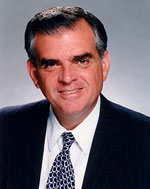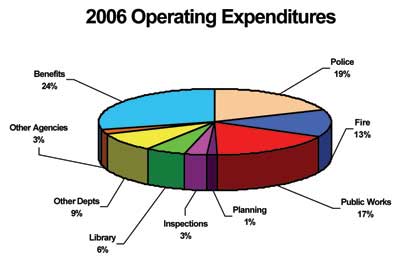 Boy is Ray on the defensive! Check out this month’s Interbusiness Issues article written by our very own U.S. Representative, “Earmark Story Misses the Mark.” It’s essentially his rebuttal to this article, written by Dori Meinert of Copley News Service, which raised questions about the ethics of LaHood giving federal money to companies that contribute heavily to his campaign.
Boy is Ray on the defensive! Check out this month’s Interbusiness Issues article written by our very own U.S. Representative, “Earmark Story Misses the Mark.” It’s essentially his rebuttal to this article, written by Dori Meinert of Copley News Service, which raised questions about the ethics of LaHood giving federal money to companies that contribute heavily to his campaign.
“I was extremely disappointed by the recent news story written by a Washington-based reporter regarding the earmark process for securing federal support for projects here in our Congressional District,” LaHood starts out, vowing to “set the record straight” and provide a “complete set of facts.”
Of the 41 projects for which I helped to secure earmarked funds in fiscal year 2006, the reporter focused her story on four—two for Caterpillar, one for Firefly Energy, and one for Proctor Hospital—and somehow tried to tie them to campaign contributions I’ve received.
“…Somehow tried to tie them to campaign contributions”? It wasn’t very hard:
- Meinert’s article tells how Bill Lane, a lobbyist for Caterpillar in Washington, co-sponsored a fundraiser that raised $16,000 for LaHood. Total earmarks for Caterpillar: $26.6 million.
- Michael Herson, who sits on LaHood’s campaign steering committee, was hired by Firefly Energy and received $40,000 over four months for his services. LaHood claims they never talked about Firefly, but they got an earmark for $2.5 million — coincidentally, of course.
- Arthur Mason, who works for Cassidy & Associates and represents Proctor Hospital, is also on LaHood’s steering committee. Proctor got a $200,000 earmark.
To see a complete list of LaHood’s earmarks for fiscal year 2006, check out the State Journal-Register (Springfield), another Copley publication.
LaHood’s response: “Never have I asked someone for a contribution in return for funding we’ve secured or work my office has done.” He goes on to defend his procurement of earmarks for Caterpillar based on the fact that Cat is such a large employer and helping them helps the economy in the 18th Congressional District. He doesn’t mention the earmarks for Firefly or Proctor at all.
But he does bring up several other earmarks — things that can’t be attributed to a quid pro quo — such as emergency radio upgrades for Peoria County, a new sanitary sewer system for Pleasant Plains, and 9-1-1 enhancement for Logan County. And he brings up earmarks that he secured for projects Copley Press supported — like the new Lincoln Presidential Library and the Peoria Next Innovation Center.
He apparently didn’t read the end of Meinert’s article, because she did, in fact, mention Peoria Next and the $1 million earmark they received — they’re also represented by Washington-based lobbyist group Cassidy & Associates.
LaHood concludes by saying, “to somehow attempt to tie me to people like Jack Abramoff or Duke Cunningham is wrong, and it gives unfair license to a reporter in creating a perception that isn’t accurate,” and then asserting his professionalism, honesty, and integrity.
LaHood’s defense is filled with logical fallacies.
First of all, to bring up all the undisputed earmarks and not mention Firefly or Proctor or his association with Cassidy & Associates is the epitome of a red herring. This is like a person caught shoplifing some candy holding up a receipt for the all the other groceries he purchased and saying, “see, I’m innocent because — look at all the other stuff I did pay for!”
Secondly, it’s a non sequitur to suggest that because he agrees with Copley Press on, say, the Innovation Center that they should therefore endorse his means of funding it. I could give a million examples of this, but let’s just take a couple. We all want adequate fire protection in Peoria, but we don’t all agree that a garbage tax is the way to fund it. We are all in favor of urban renewal, but we don’t all agree on using TIF districts to fund that, either.
But most of all, there’s this tone about the article like he just can’t understand why people are questioning him on this. Is he really so out of touch that he doesn’t realize the electorate is cynical and jaded? Can he really not see that his earmarks at least give the appearance of there being a quid pro quo? In defending himself, he should at least acknowledge that much. He should say, “Hey, I know this may look bad in light of the Abramoff scandal, and I want to ensure voters that this situation is different…,” and then proceed to explain why it’s different.
He may even want to consider returning the campaign contributions he received from Cat, Firefly, and Proctor just as a show of good faith to his constituents. This wouldn’t be unprecedented since he states in his article, “we routinely return contributions my campaign receives that include a letter or note referencing assistance someone has received from my office or how I voted on legislation.” Since these contributions and related earmarks are causing so much controversy, why not just give up the campaign money? It’s not like he’s hurting for funds in his war chest, and no one is opposing him in the midterm elections.
In the end, the reason it’s so hard for LaHood to prove his innocence is because the earmark system is inherently flawed. Earmarks offer no checks or balances or any accountability for how funds are distributed. The best solution is the one LaHood rejects — abolish earmarks altogether.
LaHood says, “I believe the representatives of an area know their constituents’ priorities better than some Washington bureaucrat.” So, in LaHood’s logic, the two choices are letting him dole out the funds or letting a “Washington bureaucrat” dole out the funds. Hogwash. Why are these funds funneling through Washington at all? If they have all this extra money for our local needs, they should reduce our tax burden and let the local/state governments tax that money for their needs directly. In the case of military contracts, they should bid them out fairly, not have LaHood or other representatives choose the winners and losers. Any other projects that require federal funding should go through the legislative process as a separate bill, not be tacked on to an unrelated bill.
If LaHood were a real leader, he’d work for real reform.


